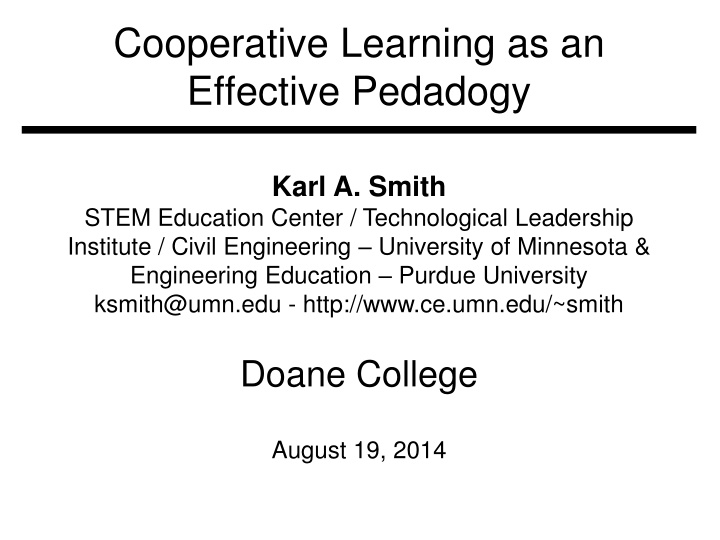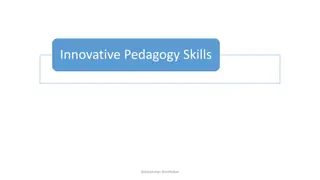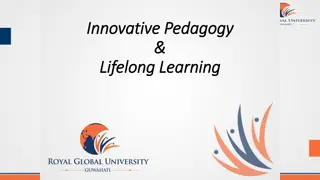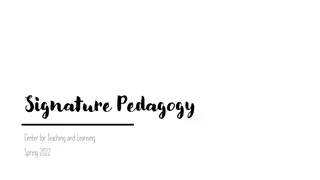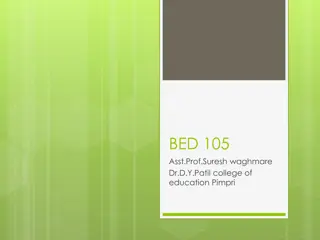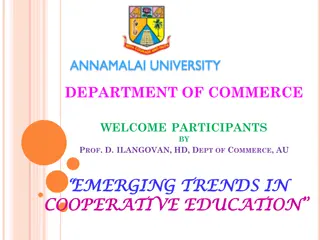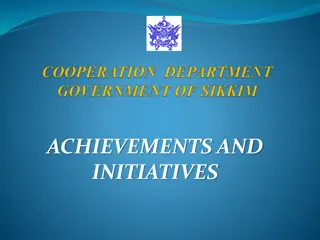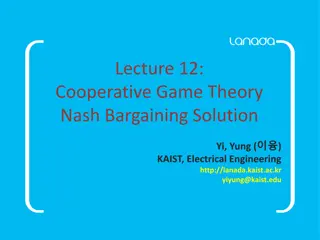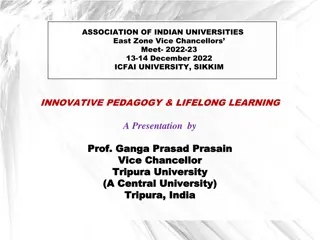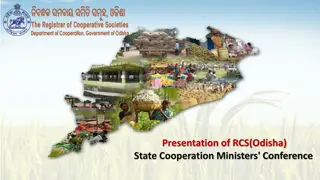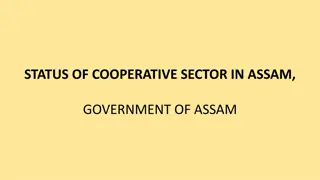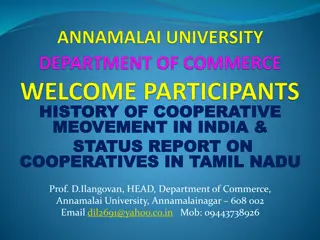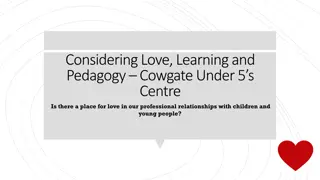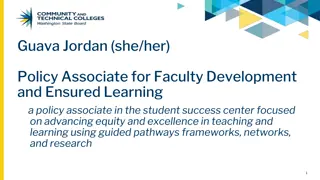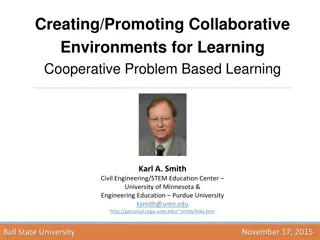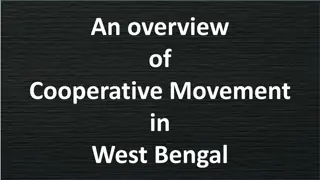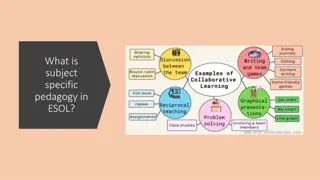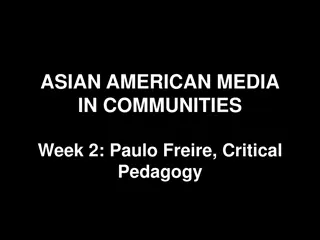Enhancing Learning Through Cooperative Pedagogy
Explore the effective pedagogy of cooperative learning with Karl A. Smith. Understand essential student learning outcomes, session layout, overall goals, workshop objectives, and engage in reflection and dialogue to enhance educational practices. Discover key elements and strategies for facilitating learning, course design foundations, and connections to desired outcomes. Embrace the seven principles for good practice in undergraduate education.
Download Presentation

Please find below an Image/Link to download the presentation.
The content on the website is provided AS IS for your information and personal use only. It may not be sold, licensed, or shared on other websites without obtaining consent from the author.If you encounter any issues during the download, it is possible that the publisher has removed the file from their server.
You are allowed to download the files provided on this website for personal or commercial use, subject to the condition that they are used lawfully. All files are the property of their respective owners.
The content on the website is provided AS IS for your information and personal use only. It may not be sold, licensed, or shared on other websites without obtaining consent from the author.
E N D
Presentation Transcript
Cooperative Learning as an Effective Pedadogy Karl A. Smith STEM Education Center / Technological Leadership Institute / Civil Engineering University of Minnesota & Engineering Education Purdue University ksmith@umn.edu - http://www.ce.umn.edu/~smith Doane College August 19, 2014
Essential Student Learning Outcomes of the Undergraduate Core Through the liberal arts, students will: Understand foundational areas of knowledge Develop crucial intellectual skills. Build connections of knowledge across various disciplines. Adapt their liberal education to serve and to lead at all levels of citizenship. Important complementary habits of anintellectual and balanced life will be developed through the depth and breadth of their entire collegiate experience - curricular, co-curricular and extracurricular
Session Layout Welcome & Overview Cooperative Learning Rationale Key Elements Course Design Foundations How People Learn Understanding by Design Applications of Cooperative Learning 3
Overall Goal Build your knowledge of cooperative learning and your repertoire of cooperative learning strategies 4
Workshop Objectives Participants will be able to : Describe key features of cooperative learning and effective, interactive strategies for facilitating learning Summarize key elements of Course Design Foundations How People Learn (HPL) Understanding by Design (UbD) process Content (outcomes) Assessment Pedagogy Explain key features of and rationale for Cooperative Learning Identify connections between cooperative learning and desired outcomes of courses and programs Participants will begin applying key elements to the design on a course, class session or learning module 5
Reflection and Dialogue Individually reflect on your favorite rationale for Engaged Pedagogies, such as Cooperative Learning. Write for about 1 minute Context/Audience? Who is the focus, e.g., students? Claim? What is the nature of the rationale? Evidence? Support for your claim Discuss with your neighbor for about 2 minutes Select/create a response to present to the whole group if you are randomly selected
Seven Principles for Good Practice in Undergraduate Education Good practice in undergraduate education: Encourages student-faculty contact Encourages cooperation among students Encourages active learning Gives prompt feedback Emphasizes time on task Communicates high expectations Respects diverse talents and ways of learning Chickering & Gamson, June, 1987 http://learningcommons.evergreen.edu/pdf/fall1987.pdf 7
Discipline-Based Education Research (DBER) Report Update Discipline-Based Education Research Practitioner Guide In Preparation Coming 2014 Reaching Students: What Research Says About Effective Instruction in Undergraduate Science and Engineering ASEE Prism Summer 2013 National Research Council Summer 2012 http://www.nap.edu/ catalog.php?record_id=13362 Journal of Engineering Education Editorial October, 2013
Student Engagement Research Evidence Perhaps the strongest conclusion that can be made is the least surprising. Simply put, the greater the student s involvement or engagement in academic work or in the academic experience of college, the greater his or her level of knowledge acquisition and general cognitive development (Pascarella and Terenzini, 2005). Active and collaborative instruction coupled with various means to encourage student engagement invariably lead to better student learning outcomes irrespective of academic discipline (Kuh et al., 2005, 2007). See Smith, et.al, 2005 and Fairweather, 2008, Linking Evidence and Promising Practices in Science, Technology, Engineering, and Mathematics (STEM) Undergraduate Education - http://www7.nationalacademies.org/bose/Fairweather_CommissionedPaper.pdf 10
Engaged Pedagogies = Reduced Failure Rates Evidence-based research on learning indicates that when students are actively involved in their education they are more successful and less likely to fail. A new PNAS report by Freeman et al., shows a significant decrease of failure rate in active learning classroom compared to traditional lecture Freeman, Scott; Eddy, Sarah L.; McDonough, Miles; Smith, Michelle K.; Okoroafor, Nnadozie; Jordt, Hannah; Wenderoth, Mary Pat; Active learning increases student performance in science, engineering, and mathematics, 2014, Proc. Natl. Acad. Sci. 11
Process Metallurgy Dissolution Kinetics liquid-solid interface Iron Ore Desliming solid-solid interface Metal-oxide reduction roasting gas- solid interface
Dissolution Kinetics Theory Governing Equation for Mass Transport Research rotating disk Practice leaching of silver bearing metallic copper & printed circuit-board waste = 2 ( ) c v D c 2 dc d c = vy D 2 dy dy
First Teaching Experience Practice Third-year course in metallurgical reactions thermodynamics and kinetics
Engineering Education Practice Third-year course in metallurgical reactions thermodynamics and kinetics Research ? Theory ? Theory Research Evidence Practice
University of Minnesota College of Education Social, Psychological and Philosophical Foundations of Education Statistics, Measurement, Research Methodology Assessment and Evaluation Learning and Cognitive Psychology Knowledge Acquisition, Artificial Intelligence, Expert Systems Development Theories Motivation Theories Social psychology of learning student student interaction
Cooperative Learning Theory Social Interdependence Lewin Deutsch Johnson & Johnson Research Randomized Design Field Experiments Practice Formal Teams/Professor s Role Theory Research Evidence Practice
Cooperative Learning Introduced to Engineering 1981 Smith, K.A., Johnson, D.W. and Johnson, R.T., 1981. The use of cooperative learning groups in engineering education. In L.P. Grayson and J.M. Biedenbach (Eds.), Proceedings Eleventh Annual Frontiers in Education Conference, Rapid City, SD, Washington: IEEE/ASEE, 26-32. 20 JEE December 1981
Cooperative Learning Research Support Johnson, D.W., Johnson, R.T., & Smith, K.A. 1998. Cooperative learning returns to college: What evidence is there that it works? Change, 30 (4), 26-35. Over 300 Experimental Studies First study conducted in 1924 High Generalizability Multiple Outcomes Outcomes 1. Achievement and retention 2. Critical thinking and higher-level reasoning 3. Differentiated views of others 4. Accurate understanding of others' perspectives 5. Liking for classmates and teacher 6. Liking for subject areas 7. Teamwork skills Johnson, D. W., Johnson, R. T., & Smith, K. A. (2014). Cooperative learning: Improving university instruction by basing practice on validated theory. Journal on Excellence in College Teaching, 25(3&4) January 2005 March 2007
Throughout the whole enterprise, the core issue, in my view, is the mode of teaching and learning that is practiced. Learning about things does not enable students to acquire the abilities and understanding they will need for the twenty-first century. We need new pedagogies of engagement that will turn out the kinds of resourceful, engaged workers and citizens that America now requires. Russ Edgerton (reflecting on higher education projects funded by the Pew Memorial Trust) 22 http://www.asee.org/publications/jee/issueList.cfm?year=2005#January2005
Reflection and Dialogue Individually reflect on your mental image of an effective teacher. Write for about 1 minute. Jot down words or phrases Construct a figure or diagram Discuss with your neighbor for about 2 minutes Describe your mental image and talk about similarities and differences Select one Element, Image, Comment, Story, etc. that you would like to present to the whole group if you are randomly selected Whole group discussion
Teacher Mental Images About Teaching - Axelrod (1973) Mental Image Motto Characteristics Disciplines Content I teach what I know I teach what I am Pour it in, Lecture Modeling, Demonstration Science, Math Instructor Many Student Cognitive Development Student Development of Whole Person I train minds Active Learning, Discussion English, Humanities I work with students as people Motivation, Self- esteem Basic Skills Teachers Axelrod, J. The University Teacher as Artist. San Francisco: Jossey-Bass, 1973. 24
Cooperative Learning is instruction that involves people working in teams to accomplish a common goal, under conditions that involve both positive interdependence (all members must cooperate to complete the task) and individual and group accountability (each member is accountable for the complete final outcome). Key Concepts Positive Interdependence Individual and Group Accountability Face-to-Face Promotive Interaction Teamwork Skills Group Processing http://www.ce.umn.edu/~smith/docs/Smith-CL%20Handout%2008.pdf
The American College Teacher: National Norms for 2007-2008 Methods Used in All or Most Cooperative Learning Group Projects All 2005 48 All 2008 59 Assistant - 2008 66 33 36 61 Grading on a curve Term/research papers 19 17 14 35 44 47 27 http://www.heri.ucla.edu/index.php
Undergraduate Teaching Faculty, 2011* STEM women 60% STEM men 41% All other women 72% All other men 53% Methods Used in All or Most Cooperative learning Group projects 36% 27% 38% 29% Grading on a curve 17% 31% 10% 16% Student inquiry 43% 33% 54% 47% Extensive lecturing 50% 70% 29% 44% *Undergraduate Teaching Faculty. National Norms for the 2010-2011 HERI Faculty Survey, www.heri.ucla.edu/index.php
It could well be that faculty members of the twenty-first century college or university will find it necessary to set aside their roles as teachers and instead become designers of learning experiences, processes, and environments. James Duderstadt, 1999 Nuclear Engineering Professor; Former Dean, Provost and President of the University of Michigan
Course Design Foundations Science of Instruction (UbD) No Yes Good Theory/ Poor Practice Good Theory & Good Practice Yes Science of Learning (HPL) Good Practice/ Poor Theory No Bransford, Brown Cocking. 1999. How People Learn. National Academy Press. Wiggins McTighe, 2005. Understanding by Design, 2ed. ASCD. Bransford, Brown & Cocking. 1999. How People Learn. National Academy Press. Wiggins & McTighe, 2005. Understanding by Design, 2ed. ASCD.
How People Learn (HPL) HPL Expertise implies (Ch. 2): a set of cognitive and metacognitive skills an organized body of knowledge that is deep and contextualized an ability to notice patterns of information in a new situation flexibility in retrieving and applying that knowledge to a new problem Framework Bransford, Brown & Cocking. 1999. How people learn. National Academy Press.
Understanding by Design Stage 1. Identify Desired Results Enduring understanding (enduring outcomes) Important to know and do Worth being familiar with Stage 2. Determine Acceptable Evidence Stage 3. Plan Learning Experiences and Instruction Overall: Are the desired results, assessments, and learning activities ALIGNED? Wiggins & McTighe, 1997, 2005. Understanding by Design. Alexandria, VA: ASCD.
Bransford, Vye and Bateman Creating High Quality Learning Environments
1. Students prior knowledge can help or hinder learning 2. How student organize knowledge influences how they learn and apply what they know 3. Students motivation determines, directs, and sustains what they do to learn 4. To develop mastery, students must acquire component skills, practice integrating them, and know when to apply what they have learned 5. Goal-directed practice coupled with targeted feedback enhances the quality of students learning 6. Students current level of development interacts with the social, emotional, and intellectual climate of the course to impact learning 7. To become self-directed learners, students must learn to monitor and adjust their approach to learning
Active Learning: Cooperation in the College Classroom Informal Cooperative Learning Groups Formal Cooperative Learning Groups Cooperative Base Groups Notes: Cooperative Learning Handout (CL-College-814.doc) 35
Book Ends on a Class Session Smith, K.A. 2000. Going deeper: Formal small-group learning in large classes. Energizing large classes: From small groups to learning communities. New Directions for Teaching and Learning, 2000, 81, 25-46. [NDTL81Ch3GoingDeeper.pdf] 36
Informal CL (Book Ends on a Class Session) with Concept Tests Physics Eric Mazur - Harvard http://galileo.harvard.edu Peer Instruction http://mazur.harvard.edu/research/detailspage.php?rowid=8 Richard Hake http://www.physics.indiana.edu/~hake/ Chemistry Chemistry ConcepTests - UW Madison - http://chemcollective.org/tests Video: Making Lectures Interactive with ConcepTests http://www.wcer.wisc.edu/archive/cl1/flag/cat/contests/contests7.htm ModularChem Consortium http://chemconnections.org/ STEMTEC - http://k12s.phast.umass.edu/stemtec/ Video: How Change Happens: Breaking the Teach as You Were Taught Cycle Films for the Humanities & Sciences www.films.com Harvard Derek Bok Center Thinking Together & From Questions to Concepts: Interactive Teaching in Physics http://bokcenter.harvard.edu/ 39
40 http://groups.physics.umn.edu/physed/Research/MNModel/Model.html
Conceptual Understanding http://groups.physics.umn.edu/physed/Research/MNModel/FCI.html
Physics (Mechanics) Concepts: The Force Concept Inventory (FCI) A 30 item multiple choice test to probe student's understanding of basic concepts in mechanics. The choice of topics is based on careful thought about what the fundamental issues and concepts are in Newtonian dynamics. Uses common speech rather than cueing specific physics principles. The distractors (wrong answers) are based on students' common inferences. 42
Workshop Biology Traditional passive lecture vs. Workshop biology Source: Udovic et al. 2002
Biology Source: Knight, J. and Wood, W. (2005). Teaching more by lecturing less. Cell Biol Educ. 4(4): 298 310.
Informal Cooperative Learning Groups Can be used at any time Can be short term and ad hoc May be used to break up a long lecture Provides an opportunity for students to process material they have been listening to (Cognitive Rehearsal) Are especially effective in large lectures Include "book ends" procedure Are not as effective as Formal Cooperative Learning or Cooperative Base Groups
Strategies for Energizing Large Classes: From Small Groups to Learning Communities: Jean MacGregor, James Cooper, Karl Smith, Pamela Robinson New Directions for Teaching and Learning, No. 81, 2000. Jossey- Bass
Active Learning: Cooperation in the College Classroom Informal Cooperative Learning Groups Formal Cooperative Learning Groups Cooperative Base Groups See Cooperative Learning Handout (CL College-912.doc) 48
Formal Cooperative Learning Task Groups
Instructor's Role in Formal Cooperative Learning 1. Specifying Objectives 2. Making Decisions 3. Explaining Task, Positive Interdependence, and Individual Accountability 4. Monitoring and Intervening to Teach Skills 5. Evaluating Students' Achievement and Group Effectiveness 50
Decisions,Decisions Group size? Group selection? Group member roles? How long to leave groups together? Arranging the room? Providing materials? Time allocation? 51
Formal Cooperative Learning Types of Tasks 1. Jigsaw Learning new conceptual/procedural material 2. Peer Composition or Editing 3. Reading Comprehension/Interpretation 4. Problem Solving, Project, or Presentation 5. Review/Correct Homework 6. Constructive Controversy 7. Group Tests
